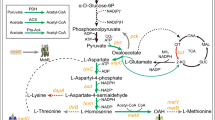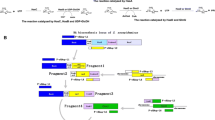Abstract
The molecular weight of hyaluronic acid (HA) is a critical property which determines its usage in various biomedical applications. This study investigates the correlation between the availability of a critical cofactor, acetyl-CoA, the concentration of a limiting precursor, UDP-N-acetylglucosamine (UDP-GlcNAc), and the molecular weight of HA (MWHA) produced by recombinant Lactococcus lactis MKG6 cultures. This strain expressed three heterologous HA-pathway genes obtained from the has operon of Streptococcus zooepidemicus in an ldh-mutant host strain, L. lactis NZ9020. A flux balance analysis, performed using the L. lactis genome-scale metabolic network, showed a positive correlation of acetyl-CoA flux with the UDP-GlcNAc flux and the experimental data on HA productivity. To increase the intracellular levels of acetyl-CoA, acetate was supplemented as a pulse feed in anaerobic batch cultures. However, acetate is effectively utilized only in the presence of glucose and exhaustion of glucose resulted in decreasing the final MWHA (1.5 MDa). Co-supplementation of acetate resulted in enhancing the acetyl-CoA and UDP-GlcNAc levels as well as the MWHA to 2.5 MDa. This logic was extended to fed-batch cultures, designed with a pH-based feedback control of glucose feeding and pulse acetate supplementation. When the glucose feed concentration was optimally adjusted to prevent glucose exhaustion or accumulation, the acetate utilization was found to be high, resulting in significantly enhanced levels of acetyl-CoA and UDP-GlcNAc as well as a MWHA of 3.4 MDa, which was sustained at this value throughout the process. This study provides the possibility of commercially producing high MWHA using recombinant L. lactis strains.








Similar content being viewed by others
References
Avidan O, Brandis A, Rogachev I, Pick U (2015) Enhanced acetyl-CoA production is associated with increased triglyceride accumulation in the green alga Chlorella desiccata. J Exp Bot 66:3725–3735. https://doi.org/10.1093/jxb/erv166
Badle SS, Jayaraman G, Ramachandran KB (2014) Ratio of intracellular precursors concentration and their flux influences hyaluronic acid molecular weight in Streptococcus zooepidemicus and recombinant Lactococcus lactis. Bioresour Technol 163:222–227. https://doi.org/10.1016/j.biortech.2014.04.027
Badri A, Raman K, Jayaraman G, (2019) Uncovering Novel Pathways for Enhancing Hyaluronan Synthesis in Recombinant Lactococcus lactis: Genome-ScaleMetabolic Modeling and Experimental Validation. Processes 7 (6):343. https://doi.org/10.3390/pr7060343
Boynton ZL, Bennett GN, Rudolph FB (1994) Intracellular concentrations of coenzyme A and its derivatives from Clostridium acetobutylicum ATCC 824 and their roles in enzyme regulation. Appl Environ Microbiol 60:39–44. https://doi.org/10.3103/S1063457609050050
Chauhan AS, Badle SS, Ramachandran KB, Jayaraman G (2014) The P170 expression system enhances hyaluronan molecular weight and production in metabolically-engineered Lactococcus lactis. Biochem Eng J 90:73–78. https://doi.org/10.1016/j.bej.2014.05.012
Chen Y, Daviet L, Schalk M, Siewers V, Nielsen J (2013) Establishing a platform cell factory through engineering of yeast acetyl-CoA metabolism. Metab Eng 15:48–54
Chen WY, Marcellin E, Steen JA, Nielsen LK (2014) The role of hyaluronic acid precursor concentrations in molecular weight control in Streptococcus zooepidemicus. Mol Biotechnol 56:147–156. https://doi.org/10.1007/s12033-013-9690-4
Cheng F, Gong Q, Yu H, Stephanopoulos G (2016) High-titer biosynthesis of hyaluronic acid by recombinant Corynebacterium glutamicum. Biotechnol J 11:574–584. https://doi.org/10.1002/biot.201500404
Chong BF, Nielsen LK (2003) Aerobic cultivation of Streptococcus zooepidemicus and the role of NADH oxidase. Biochem Eng J 16:153–162. https://doi.org/10.1016/S1369-703X(03)00031-7
Flahaut NAL, Wiersma A, Van De BB, Martens DE, Schaap PJ, Sijtsma L, Santos DVAM, De Vos WM (2013) Genome-scale metabolic model for Lactococcus lactis MG1363 and its application to the analysis of flavor formation. Appl Microbiol Biotechnol 97:8729–8739. https://doi.org/10.1007/s00253-013-5140-2
Gao H, Du G, Chen J (2006) Analysis of metabolic fluxes for hyaluronic acid (HA) production by Streptococcus zooepidemicus. World J Microbiol Biotechnol 22:399–408. https://doi.org/10.1007/s11274-005-9047-7
Hmar RV, Prasad SB, Jayaraman G, Ramachandran KB (2014) Chromosomal integration of hyaluronic acid synthesis (has) genes enhances the molecular weight of hyaluronan produced in Lactococcus lactis. Biotechnol J 9:1554–1564. https://doi.org/10.1002/biot.201400215
Hols P, Ramos A, Hugenholtz J, Delcour J, De Vos WM, Santos H, Kleerebezem M (1999) Acetate utilization in Lactococcus lactis deficient in lactate dehydrogenase: a rescue pathway for maintaining redox balance. J Bacteriol 181:5521–5526
Jagannath S, Ramachandran KB (2010) Influence of competing metabolic processes on the molecular weight of hyaluronic acid synthesized by Streptococcus zooepidemicus. Biochem Eng J 48:148–158. https://doi.org/10.1016/j.bej.2009.09.003
Jeeva P, Shanmuga Doss S, Sundaram V, Jayaraman G (2019) Production of controlled molecular weight hyaluronic acid by glucostat strategy using recombinant Lactococcus lactis cultures. Appl Microbiol Biotechnol 103:4363–4375. https://doi.org/10.1007/s00253-019-09769-0
Jeong E, Shim WY, Kim JH (2014) Metabolic engineering of Pichia pastoris for production of hyaluronic acid with high molecular weight. J Biotechnol 185:28–36. https://doi.org/10.1016/j.jbiotec.2014.05.018
Jin P, Kang Z, Yuan P, Du G, Chen J (2016) Production of specific-molecular-weight hyaluronan by metabolically engineered Bacillus subtilis 168. Metab Eng 35:21–30. https://doi.org/10.1016/j.ymben.2016.01.008
Kang DY, Kim W-S, Heo IS, Park YH, Lee S (2010) Extraction of hyaluronic acid (HA) from rooster comb and characterization using flow field-flow fractionation (FIFFF) coupled with multiangle light scattering (MALS). J Sep Sci 33:3530–3536. https://doi.org/10.1002/jssc.201000478
Kaur M, Jayaraman G (2016) Hyaluronan production and molecular weight is enhanced in pathway-engineered strains of lactate dehydrogenase-deficient Lactococcus lactis. Metab Eng Commun 3:15–23. https://doi.org/10.1016/j.meteno.2016.01.003
Kogan G, Solte’s L, Stern R, Gemeiner P (2006) Hyaluronic acid: a natural biopolymer with a broad range of biomedical and industrial applications. Biotechnol Lett 29:17–25. https://doi.org/10.1007/s10529-006-9219-z
Lin H, Castro NM, Bennett GN, San KY (2006) Acetyl-CoA synthetase overexpression in Escherichia coli demonstrates more efficient acetate assimilation and lower acetate accumulation: a potential tool in metabolic engineering. Appl Microbiol Biotechnol 71:870–874. https://doi.org/10.1007/s00253-005-0230-4
Liu L, Liu Y, Li J, Du G, Chen J (2011) Microbial production of hyaluronic acid: current state, challenges, and perspectives. Microb Cell Fact 10:99–108. https://doi.org/10.1186/1475-2859-10-99
Mao Z, Chen RR (2007) Recombinant synthesis of hyaluronan by Agrobacterium sp. Biotechnol Prog 23:1038–1042. https://doi.org/10.1021/bp070113n
Mierau I, Kleerebezem M (2005) 10 Years of the nisin-controlled gene expression system (NICE) in Lactococcus lactis. Appl Microbiol Biotechnol 68:705–717. https://doi.org/10.1007/s00253-005-0107-6
Nakajima K, Kitazume S, Angata T, Fujinawa R, Ohtsubo K, Miyoshi E, Taniguchi N (2010) Simultaneous determination of nucleotide sugars with ion-pair reversed-phase HPLC. Glycobiology 20:865–871. https://doi.org/10.1093/glycob/cwq044
Novak K, Flöckner L, Erian AM, Freitag P, Herwig C, Pflügl S (2018) Characterizing the effect of expression of an acetyl-CoA synthetase insensitive to acetylation on co-utilization of glucose and acetate in batch and continuous cultures of E. coli W. Microb Cell Fact 17:1–15. https://doi.org/10.1186/s12934-018-0955-2
Oueslati N, Leblanc P, Harscoat-Schiavo C, Rondags E, Meunier S, Kapel R, Marc I (2014) CTAB turbidimetric method for assaying hyaluronic acid in complex environments and under cross-linked form. Carbohydr Polym 112:102–108. https://doi.org/10.1016/j.carbpol.2014.05.039
Papagianni M, Avramidis N, Filiousis G (2007) Glycolysis and the regulation of glucose transport in Lactococcus lactis spp. lactis in batch and fed-batch culture. Microb Cell Fact 6:1–13. https://doi.org/10.1186/1475-2859-6-16
Prasad SB, Ramachandran KB, Jayaraman G (2012) Transcription analysis of hyaluronan biosynthesis genes in Streptococcus zooepidemicus and metabolically engineered Lactococcus lactis. Appl Microbiol Biotechnol 94:1593–1607. https://doi.org/10.1007/s00253-012-3944-0
Puvendran K, Anupama K, Jayaraman G (2018) Real-time monitoring of hyaluronic acid fermentation by in situ transflectance spectroscopy. Appl Microbiol Biotechnol 102:2659–2669. https://doi.org/10.1007/s00253-018-8816-9
Rajendran V, Puvendran K, Guru BR, Jayaraman G (2016) Design of aqueous two-phase systems for purification of hyaluronic acid produced by metabolically engineered Lactococcus lactis. J Sep Sci 39:655–662. https://doi.org/10.1002/jssc.201500907
Ren LJ, Huang H, Xiao AH, Lian M, Jin LJ, Ji XJ (2009) Enhanced docosahexaenoic acid production by reinforcing acetyl-CoA and NADPH supply in Schizochytrium sp. HX-308. Bioprocess Biosyst Eng 32:837–843. https://doi.org/10.1007/s00449-009-0310-4
Schellenberger J, Que R, Fleming RMT, Thiele I, Orth JD, Feist AM, Zielinski DC, Bordbar A, Lewis NE, Rahmanian S, Kang J, Hyduke DR, Palsson BØ (2011) Quantitative prediction of cellular metabolism with constraint-based models: the COBRA Toolbox v2.0. Nat Protoc 6:1290–1307. https://doi.org/10.1038/nprot.2011.308
Shanmuga Doss S, Pravinbhai N, Jayaraman G (2017) Improving the accuracy of hyaluronic acid molecular weight estimation by conventional size exclusion chromatography. J Chromatogr B 1060:255–261. https://doi.org/10.1016/j.jchromb.2017.06.006
Song AAL, In LLA, Lim SHE, Rahim RA (2017) A review on Lactococcus lactis: from food to factory. Microb Cell Fact 16:1–15. https://doi.org/10.1186/s12934-017-0669-x
Sze JH, Brownlie JC, Love CA (2016) Biotechnological production of hyaluronic acid: a mini review. 3 Biotech. https://doi.org/10.1007/s13205-016-0379-9
Vadali RV, Bennett GN, San K-Y (2004a) Cofactor engineering of intracellular CoA/acetyl-CoA and its effect on metabolic flux redistribution in Escherichia coli. Metab Eng 6:133–139. https://doi.org/10.1016/j.ymben.2004.02.001
Vadali RV, Horton CE, Rudolph FB, Bennett GN, San KY (2004b) Production of isoamyl acetate in ackA-pta and/or ldh mutants of Escherichia coli with overexpression of yeast ATF2. Appl Microbiol Biotechnol 63:698–704. https://doi.org/10.1007/s00253-003-1452-y
Yu H, Stephanopoulos G (2008) Metabolic engineering of Escherichia coli for biosynthesis of hyaluronic acid. Metab Eng 10:24–32. https://doi.org/10.1016/j.ymben.2007.09.001
Acknowledgments
The authors would like to acknowledge the support provided by the Ministry of Human Resources Development (Govt. of India), for fellowship to Kirubhakaran Puvendran. We would also like to acknowledge the Department of Chemistry, IIT Madras, for helping us with NMR spectroscopy and thermo-gravimetric analysis.
Funding
This work was financially supported by the Department of Biotechnology (Ministry of Science and Technology, Govt. of India) through Project No. BT/PR13815/BBE/117/61/2015.
Author information
Authors and Affiliations
Corresponding author
Ethics declarations
Conflict of interest
The authors declare that they have no conflict of interest.
Ethical approval
This article does not contain any studies with human participants or animals performed by any of the authors.
Additional information
Publisher’s note
Springer Nature remains neutral with regard to jurisdictional claims in published maps and institutional affiliations.
Electronic supplementary material
ESM 1
(PDF 766 kb)
Rights and permissions
About this article
Cite this article
Puvendran, K., Jayaraman, G. Enhancement of acetyl-CoA by acetate co-utilization in recombinant Lactococcus lactis cultures enables the production of high molecular weight hyaluronic acid. Appl Microbiol Biotechnol 103, 6989–7001 (2019). https://doi.org/10.1007/s00253-019-09987-6
Received:
Revised:
Accepted:
Published:
Issue Date:
DOI: https://doi.org/10.1007/s00253-019-09987-6




